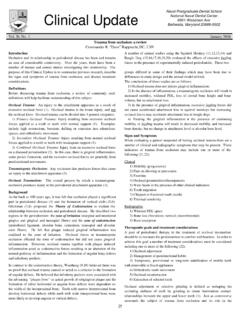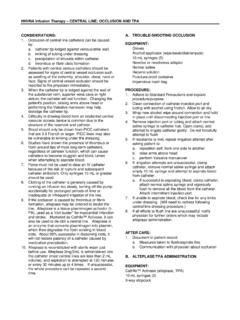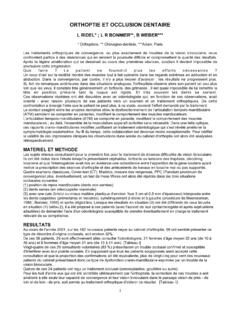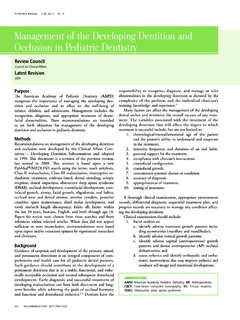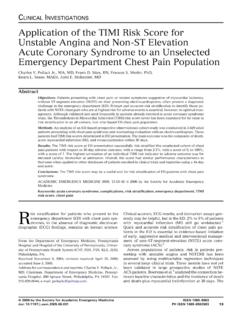Transcription of Implant occlusion: biomechanical considerations for ...
1 Review Article J Dent Sci 2008 Vo l 3 No 2 65 Received: February 29, 2008 Accepted: May 9, 2008 Reprint requests to: Dr. Yi-Bing Wang, Department of Dentistry, Tri-Service General Hospital, No. 325, Cheng-Kung Road, Sec. 2, Taipei, Taiwan 11490, ROC. Implant occlusion : biomechanical considerations for Implant -supported prostheses YU-YING CHEN1,2 CHUNG-LING KUAN1 YI-BING WANG1,2 1 Department of Dentistry, Tri-Service General Hospital, Taipei, Taiwan, ROC. 2 School of Dentistry, National Defense Medical Center, Taipei, Taiwan, ROC. Clinically, natural occlusal concepts can be applied to Implant prostheses. However, a natural tooth has a support design that reduces the forces to the surrounding crest of bone compared to the same region around an Implant .
2 If a clinical condition is likely to increase biomechanical stresses, dentists should implement occlusal mechanisms to decrease the stresses and develop an occlusal scheme that minimizes risk factors and allows the restoration to function in harmony with the rest of the stomatognathic system. By avoiding initial and long-term loss of crestal bone surrounding Implant fixtures, Implant -protected occlusion is proposed as a way to overcome mechanical stresses and strain from the oral musculature and occlusion . Implant -protected occlusion can be accomplished by increasing the surface area of implants , decreasing the width of the occlusal table, improving the force direction, and reducing the magnification of the force.
3 By doing these things, we can minimize overload on bone- Implant interfaces and Implant prostheses, to maintain an Implant load within the physiological limits of individualized occlusion , and ultimately provide long-term stability of implants and Implant prostheses. J Dent Sci, 3(2) 65 -74 , 2008 Key words: Implant occlusion , Implant -supported prostheses, dental Implant , progressive loading. After osseointegration, mechanical stresses and strains beyond the physical limits of hard tissue have been suggested as the primary cause of both initial and long-term bone loss around implants1,2. If the occlusal overload is not corrected, crestal bone loss will continue until the Implant fails3.
4 Clinical reports, including animal studies, from biomechanical evaluations, bone physiology, and research support this concept. Because occlusal overload can lead to mechanical stresses on dental implants and Implant prostheses, occlusion is a determining factor for Implant success in the long run4,5. Determining the right occlusal scheme for Implant -supported prostheses is the main issue discussed below. According to Gartner et , occlusal concepts developed from the natural dentition can be transposed to Implant support systems without fur- ther modifications, because mandibular movement, velocity, and chewing patterns are the same for patients with natural teeth and implants .
5 There are a myriad of variables in a patient population, so no one occlusal scheme can fit all Implant patients. Thus, if a clinical condition is likely to increase biomecha- nical stresses, dentists should implement occlusal mechanisms to decrease the stresses and develop an occlusal scheme that minimizes risk factors and allows the restoration to function in harmony with the rest of the stomatognathic system. This is what we call Implant -protected occlusion . Occlusal overload is often regarded as one of the main causes for peri- Implant bone loss and Implant prosthesis failure, because it can cause crestal bone loss, thus increasing the anaerobic sulcus depth and peri- Implant disease states if patients cannot clean well7,8.
6 So a proper occlusal scheme is a primary Chen, Kuan and Wang. J Dent Sci 2008 Vo l 3 No 2 66 requisite for the long-term survival of implants , especially when parafunction is present. The aims of this paper are to present the importance of Implant -protected occlusion for Implant longevity and to provide clinical guidelines for optimal Implant occlusion based on the currently available literature. Differences between natural teeth and implants Differences between natural tooth and endos- seous dental implants under occlusal loading are summarized in Table 19-16.
7 The basic difference between natural teeth and endosseous dental implants is that a natural tooth has a support design that reduces the forces to the surrounding crest of bone compared to the same region around an Implant . A natural tooth is suspended by the periodontal ligament (PDL) while an endosseous dental Implant is in direct contact with the bone through osseointegration. The PDL absorbs shocks and distributes occlusal stresses away along the axis of natural teeth. However, an endosseous dental Implant connected to the bone by osseoin- tegration lacks those advantages of the PDL. Teeth in natural dentition are retained by periodontal tissues that are uniquely innervated and structured.
8 When natural teeth are lost, both occlusion and attachment with its proprioceptive feedback mechanism are lost. When loaded, the movement patterns of natural teeth begin with the primary phase of periodontal compliance that is primarily non-linear and complex, followed by the secondary movement phase which occurs with engagement of the alveolar bone16. In contrast, the movement of an Implant under loading is dependent on linear and elastic deformation of the bone. The PDL in a natural tooth can produce differences in force adaptation compared with osseointegrated implants due to its shock-absorbing and stress-distributing functions.
9 Non-vertical forces on natural teeth during function affect only the teeth involved and are usually tolerated, whereas in implants , the effect involves the crest of the bone, which is usually traumatic to the supporting structures. According to Parfitt, a lateral force on a healthy natural tooth is rapidly dissipated away from the crest of bone toward the apex of the tooth due to the natural tooth rapidly moving 56~108 m and rotating around the apical 1/3 of the root15,17. On the other hand, movement of an Implant occurs gradually, reaching up to about 10~50 m under a similar lateral force.
10 So greater forces are concentrated on the crest of the surrounding bone of dental implants Table 1. Differences between natural teeth and implants Natural teeth implants Surrounding tissue Periodontal ligament (PDL) Osseointegration Malocclusion May be uneventful for years Crestal bone loss Non-vertical forces Relatively tolerated Traumatic to supporting bone Loading-bearing characteristics Shock-absorbing function Stress distribution Stress concentrated at crestal bone Movement patterns Primary.
